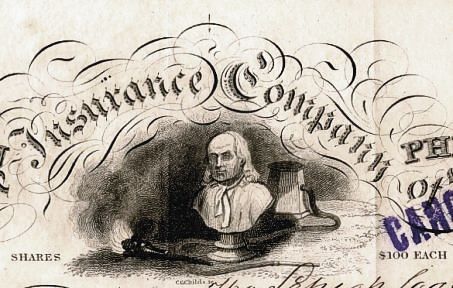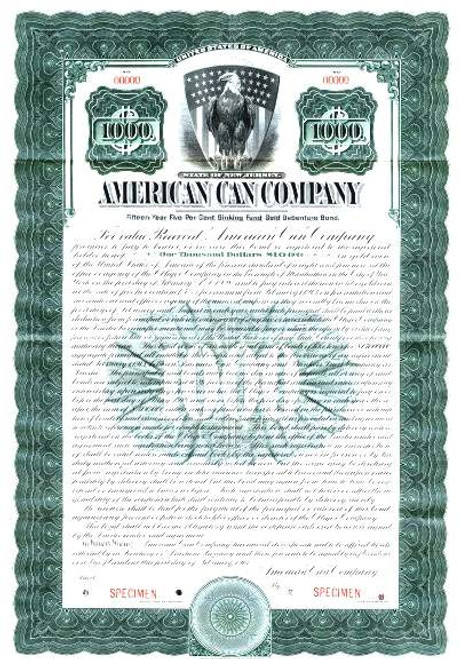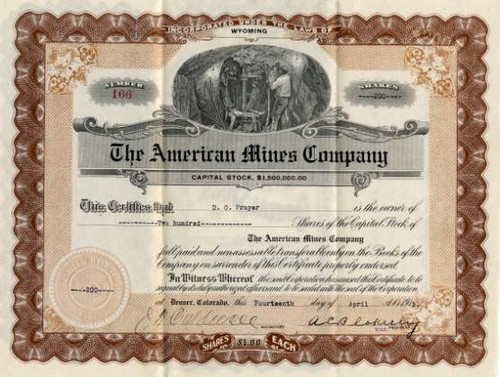Beautiful RARE stock certificate from the Franklin Fire Insurance Company of Philadelphia issued in 1836. This historic document has a vignette of a bust of Ben Franklin next to a lit torch with an early fire hose. This is the earliest insurance company stock certificate we have seen with a vignette. This item is hand signed by the Company's President, Henry C. Carey and is over 176 years old. Stamped cancelled. The certificate was issued and signed on the ledger receipt (Left Side) by Dr. Nathaniel Chapman who was one of the founders and the first president of the American Medical Association. 
Certificate Vignette Franklin Fire Insurance Company In 1829, a perpetual charter was obtained from the Pennsylvania Legislature for the incorporation of the Franklin Fire Insurance Company. This was passed by an Act of Assembly, approved and signed by Governor J. Andrew Shulze on April 22, 1829. The first meeting of the sale of stock was at Daniwl Rubican's Tavern where the stock sale was fully subscribed. The original founders of the company were Henry C. Carey, Charles N. Bancker, Clement C. Biddle, Richard Willing, James Schott, Samuel W. Jones, Thomas Hart, Thomas I. Wharton, Tobias Wanger, Charles Roberts, Levi Ellmaker and William Chaloner. In colonial America, most people warmed their homes by building a fire in a fireplace even though it was kind of dangerous and used a lot of wood. Ben Franklin figured that there had to be a better way. His invention of an iron furnace stove allowed people to warm their homes less dangerously and with less wood. The furnace stove that he invented is called a Franklin stove. Interestingly enough, Franklin also established the first fire company and the first fire insurance company in order to help people live more safely.
Nathaniel Chapman (1789-1853) Nathaniel Chapman, physician, born in Summer Hill, Fairfax County, Virginia, 28 May, 1780; died in Philadelphia, Pennsylvania, 1 July, 1853. After receiving an excellent classical education at the academy in Alexandria, Virginia, he went to Philadelphia, and was graduated at the medical department of the University of Pennsylvania in 1800. While a student, he attracted the notice of Dr. Benjamin Rush, and became one of his private pupils. At his suggestion Chapman presented an inaugural thesis on hydrophobia in answer to an attack on Dr. Rush's favorite theory on the pathology of theft disease. Subsequently he went abroad, studying for a year in London under Dr. Abernethy, and then for two years in the University of Edinburgh. He returned to the United States in 1804 and began practice in Philadelphia, where he soon became eminent. In 1810 he assisted Dr. Thomas C. James, then professor of midwifery, and three years later he became professor of materia medica in the University of Pennsylvania. In 1816 he was elected to the chair of theory and practice of medicine, which he held until 1850. He founded the medical institute in 1817, and for more than twenty years delivered a summer course of lectures in that institution, also for many years gave clinical lectures in the hospital of the Philadelphia ahnshouse. For some time he was president of the Philadelphia medical society, president of the American philosophical society (1846-'8), and the first president of the American Medical Association. In 1820 he began the publication of "The Philadelphia Journal of the Medical and Physical Sciences," which he edited for several years. Many of his lectures appeared in the "Medical Examiner" of Philadelphia during 1838-'40, and afterward were issued in book form. His published works include "Select Speeches, Forensic and Parliamentary" (Philadelphia, 1808); " Elements of Therapeutics and Materia Medica" (1828); "Lectures on Eruptive Fevers, Hemorrhages, and Dropsies, and on Gout and Rheumatism" (1844); and "Lectures on the Thoracic Viscera." A compendium of his lectures was published by Dr. N. died Benedict. Biography is from the University of Missouri.
Henry Charles Carey (1793 - 1879) One of the most highly regarded and best known economist of the early eighteen hundreds was Henry Carey. He was especially well known outside of America. Henry Carey was the son of the noted Philadelphia publisher Matthew Carey and was an Irish immigrant. He purchased control of his father's firm in 1821. He formed a successful partnership with his brother-in-law, Isaac Lea, which became a pioneer in the mass marketing of books. Carey founded the first Book Trade Sale in 1824. Carey wrote on economics and tariffs, authoring such works as Harmony of Interest and Principles of Political Economy, and headed the American Philosophical Society. Henry Carey was "a businessman-economist with a distinctly American view of the subject; his prolific writings concentrated on the harmony of economic interests. This involved a break with Malthus's and Ricardo's ideas on free trade, population, rent and wages. Increasingly he became a committed protectionist. His works made extensive use of historical and statistical data, the latter frequently presented in graphic terms". Who's Who in Economics. He was author of Essay on the Rate of Wages 1835, Principles of Political Economy 1837, The Slave Trade 1853, The Principles of Social Science 1858-60 and many pamphlets. Biography is from the Who's Who in Economics.
American Medical Association The American Medical Association was founded on May 7,1847 to act as the unified voice of physicians working together to improve health care across the country. Since its formation, the AMA has worked to advance the art and science of medicine. Guiding the enforcement of the AMA' s high standards has been the Code of Ethics, first written in 1847. The AMA' s Code of Medical Ethics has served over the years as a code of conduct for physicians to apply to all issues of health care, including the complex bio-ethical issues of today' s modern medicine. AMA History 1847, Dr. Nathan Smith Davis and others established the AMA. He wanted to "elevate the standard of medical education in the United States." It was considered "impractical, if not Utopian" by some. The goals of the AMA were scientific advancement, standards for medical education, launching a program of medical ethics, and improved public health. 250 delegates from 28 states attended the founding meeting at the Academy of Natural Sciences of Philadelphia, Pennsylvania. Dr. Nathaniel Chapman was the first president of the AMA. 1848, the AMA notes the dangers of secretive remedies and patent medicine. 1858, the AMA established the Committee on Ethics. 1864-1865, Dr. Davis was president of the AMA during the Civil War. 1873, AMA Judicial Council is founded. 1884, the AMA supports experimentation on animals. 1897, the AMA is incorporated. 1898, AMA creates the Committee on Scientific Research to provide grants for medical research. 1899, AMA creates Committee on National Legislation to represent AMA's interests in US Government. 1902, AMA gets its first permanent headquarters in Chicago. 1904, AMA establishes the Council on Medical Education to accelerate campaign to raise educational requirements for physicians [2]. 1905, AMA creates the Council on Pharmacy and Chemistry to set standards for drug manufacturing and advertising. The Council also fights against quack patent medicines. 1912, The Federation of State Medical Boards is created. It accepts the AMA's rating of medical schools as authoritative. 1927, AMA Council on Medical Education and Hospitals publishes first list of hospitals approved for residency training. 1935, Social Security Act is approved. 1943, AMA opens an office in Washington DC. 1952, House of Delegates adopted a council report condemning fee splitting in health care. 1960, AMA states that a blood alcohol level of 0.1% should be accepted as evidence of alcohol intoxication. 1970, AMA encourages the Federal Aviation Administration to require all airlines to separate nonsmokers from smokers. 1974, AMA gives recommendations to insure adequate protection of individuals used in human medical experimentation. 1976, AMA Section on Medical Schools is created. 1982, AMA urges each state medical society to support laws to raise the legal drinking age to 21. 1987, in Wilk v. American Medical Association, U.S. District Court Judge Susan Getzendanner found that the AMA violated § 1 of the Sherman Act, 15 U.S.C. § 1, by conducting an illegal boycott in restraint of trade directed at chiropractors (895 F.2d 352) 1988, AMA creates the Office of HIV/AIDS. 1995, AMA starts campaign for liability reform. 1999, AMA creates Physicians for Responsible Negotiations (PRN, a labor organization to represent doctors, allowing them to advocate on behalf of their patients. 2000, AMA supports Patients' Bill of Rights legislation in Congress. 2001, Shortly after Sept. 11th disaster, the AMA provided the government with a list of 3,500 volunteer doctors who were ready to help. The AMA educated U.S. patients and doctors about bioterrorism and disaster preparedness through public service announcements and by posting updated information on its Web site. History from Wikipedia.

Certificate Vignette
Nathaniel Chapman (1789-1853) Nathaniel Chapman, physician, born in Summer Hill, Fairfax County, Virginia, 28 May, 1780; died in Philadelphia, Pennsylvania, 1 July, 1853. After receiving an excellent classical education at the academy in Alexandria, Virginia, he went to Philadelphia, and was graduated at the medical department of the University of Pennsylvania in 1800. While a student, he attracted the notice of Dr. Benjamin Rush, and became one of his private pupils. At his suggestion Chapman presented an inaugural thesis on hydrophobia in answer to an attack on Dr. Rush's favorite theory on the pathology of theft disease. Subsequently he went abroad, studying for a year in London under Dr. Abernethy, and then for two years in the University of Edinburgh. He returned to the United States in 1804 and began practice in Philadelphia, where he soon became eminent. In 1810 he assisted Dr. Thomas C. James, then professor of midwifery, and three years later he became professor of materia medica in the University of Pennsylvania. In 1816 he was elected to the chair of theory and practice of medicine, which he held until 1850. He founded the medical institute in 1817, and for more than twenty years delivered a summer course of lectures in that institution, also for many years gave clinical lectures in the hospital of the Philadelphia ahnshouse. For some time he was president of the Philadelphia medical society, president of the American philosophical society (1846-'8), and the first president of the American Medical Association. In 1820 he began the publication of "The Philadelphia Journal of the Medical and Physical Sciences," which he edited for several years. Many of his lectures appeared in the "Medical Examiner" of Philadelphia during 1838-'40, and afterward were issued in book form. His published works include "Select Speeches, Forensic and Parliamentary" (Philadelphia, 1808); " Elements of Therapeutics and Materia Medica" (1828); "Lectures on Eruptive Fevers, Hemorrhages, and Dropsies, and on Gout and Rheumatism" (1844); and "Lectures on the Thoracic Viscera." A compendium of his lectures was published by Dr. N. died Benedict. Biography is from the University of Missouri.
Henry Charles Carey (1793 - 1879) One of the most highly regarded and best known economist of the early eighteen hundreds was Henry Carey. He was especially well known outside of America. Henry Carey was the son of the noted Philadelphia publisher Matthew Carey and was an Irish immigrant. He purchased control of his father's firm in 1821. He formed a successful partnership with his brother-in-law, Isaac Lea, which became a pioneer in the mass marketing of books. Carey founded the first Book Trade Sale in 1824. Carey wrote on economics and tariffs, authoring such works as Harmony of Interest and Principles of Political Economy, and headed the American Philosophical Society. Henry Carey was "a businessman-economist with a distinctly American view of the subject; his prolific writings concentrated on the harmony of economic interests. This involved a break with Malthus's and Ricardo's ideas on free trade, population, rent and wages. Increasingly he became a committed protectionist. His works made extensive use of historical and statistical data, the latter frequently presented in graphic terms". Who's Who in Economics. He was author of Essay on the Rate of Wages 1835, Principles of Political Economy 1837, The Slave Trade 1853, The Principles of Social Science 1858-60 and many pamphlets. Biography is from the Who's Who in Economics.
American Medical Association The American Medical Association was founded on May 7,1847 to act as the unified voice of physicians working together to improve health care across the country. Since its formation, the AMA has worked to advance the art and science of medicine. Guiding the enforcement of the AMA' s high standards has been the Code of Ethics, first written in 1847. The AMA' s Code of Medical Ethics has served over the years as a code of conduct for physicians to apply to all issues of health care, including the complex bio-ethical issues of today' s modern medicine. AMA History 1847, Dr. Nathan Smith Davis and others established the AMA. He wanted to "elevate the standard of medical education in the United States." It was considered "impractical, if not Utopian" by some. The goals of the AMA were scientific advancement, standards for medical education, launching a program of medical ethics, and improved public health. 250 delegates from 28 states attended the founding meeting at the Academy of Natural Sciences of Philadelphia, Pennsylvania. Dr. Nathaniel Chapman was the first president of the AMA. 1848, the AMA notes the dangers of secretive remedies and patent medicine. 1858, the AMA established the Committee on Ethics. 1864-1865, Dr. Davis was president of the AMA during the Civil War. 1873, AMA Judicial Council is founded. 1884, the AMA supports experimentation on animals. 1897, the AMA is incorporated. 1898, AMA creates the Committee on Scientific Research to provide grants for medical research. 1899, AMA creates Committee on National Legislation to represent AMA's interests in US Government. 1902, AMA gets its first permanent headquarters in Chicago. 1904, AMA establishes the Council on Medical Education to accelerate campaign to raise educational requirements for physicians [2]. 1905, AMA creates the Council on Pharmacy and Chemistry to set standards for drug manufacturing and advertising. The Council also fights against quack patent medicines. 1912, The Federation of State Medical Boards is created. It accepts the AMA's rating of medical schools as authoritative. 1927, AMA Council on Medical Education and Hospitals publishes first list of hospitals approved for residency training. 1935, Social Security Act is approved. 1943, AMA opens an office in Washington DC. 1952, House of Delegates adopted a council report condemning fee splitting in health care. 1960, AMA states that a blood alcohol level of 0.1% should be accepted as evidence of alcohol intoxication. 1970, AMA encourages the Federal Aviation Administration to require all airlines to separate nonsmokers from smokers. 1974, AMA gives recommendations to insure adequate protection of individuals used in human medical experimentation. 1976, AMA Section on Medical Schools is created. 1982, AMA urges each state medical society to support laws to raise the legal drinking age to 21. 1987, in Wilk v. American Medical Association, U.S. District Court Judge Susan Getzendanner found that the AMA violated § 1 of the Sherman Act, 15 U.S.C. § 1, by conducting an illegal boycott in restraint of trade directed at chiropractors (895 F.2d 352) 1988, AMA creates the Office of HIV/AIDS. 1995, AMA starts campaign for liability reform. 1999, AMA creates Physicians for Responsible Negotiations (PRN, a labor organization to represent doctors, allowing them to advocate on behalf of their patients. 2000, AMA supports Patients' Bill of Rights legislation in Congress. 2001, Shortly after Sept. 11th disaster, the AMA provided the government with a list of 3,500 volunteer doctors who were ready to help. The AMA educated U.S. patients and doctors about bioterrorism and disaster preparedness through public service announcements and by posting updated information on its Web site. History from Wikipedia.








